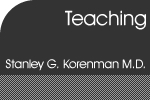

|
<< Previous Section | < Previous Page | Next Page > | Next Section >>
Bibliography (page 10 of 13) Psaty, B. M. and D. Rennie (2003). "Stopping Medical Research to Save Money: A Broken Pact With Researchers and Patients." JAMA 289(16): 2128-2131. This report documents a case in which a drug company decided that its cancer drug was no longer worth developing and stopped a trial even though they had promised a longer trial in writing. Both the company and the institution were sued. Ramsay, S. (2001). "Online database reveals researchers' industry ties." The Lancet 357(9269): 1977. This neat idea reveals the great extent to which those conducting clinical research have industry income associated with that activity. The list proceeds apace. Roberts, T. G., Jr. and B. A. Chabner (2004). "Beyond Fast Track for Drug Approvals." N Engl J Med 351(5): 501-505. Clinical Trials. Deals with fast track mechanism and the importance of selecting probable responses to each new drug. Proposes "selective approval mechanism." Scherer, F. M. (2004). "The Pharmaceutical Industry -- Prices and Progress." N Engl J Med 351(9): 927-932. This report examines the cost and pricing structures of pharmaceutical companies and tries to deal constructively with the demands for lower prices while at the same time supporting costly research. It is a very wor thwhile read. Schulman, K. A., D. M. Seils, et al. (2002). "A National Survey of Provisions in Clinical-Trial Agreements between Medical Schools and Industry Sponsors." N Engl J Med 347(17): 1335-1341. Concerned about threats to the integrity of clinical trials in a research environment increasingly controlled by private interests, the International Committee of Medical Journal Editors (ICMJE) has issued revised guidelines for investigators' participation in the study design, access to data, and control over publication. It is unclear whether research conducted at academic institutions adheres to these new standards. From November 2001 through January 2002, they interviewed officials at U.S. medical schools about provisions in their institutions' agreements with industry sponsors of multicenter clinical trials. The results demonstrated limited adherence to the standards embodied in the new ICMJE guidelines. Scores for coordinating-center agreements were somewhat higher for most survey items. They suggest that a reevaluation of the process of contracting for clinical research is urgently needed. Univ. of California Senate. (2004). Report of the University Committee on Research Policy: Problematic Restrictive Clauses in Contracts, Grants and Gifts for Research, University Committee on Research Policy. Steinbrook, R. (2004). "Conflicts of Interest at the NIH -- Resolving the Problem." N Engl J Med 351(10): 955-957. This intermediate report discusses the various ideas that were considered at the NIH in an attempt to silence criticism while maintaining leeway for extra income for investigators. The, Editor. (2004). "Publishing Commentary by Authors with Potential Conflicts of Interest: When, Why, and How." Ann Intern Med 141(1): 73-74. This describes their policies at the time. Weiss, R. (2004). NIH Bans Collaboration With Outside Companies. Washington Post. September 24, 2004. This was the first response to the revelations of the extent of conflicts of interest at the NIH. Williams, S. (2002). "Handle With Care: Avoiding Financial Conflict of Interest in Clinical Research." Academic Physician and Scientist January/February: 1, 10-12. This paper begins by discussion the plight of the Fred Hutchison Cancer Research Center when sued by research subjects' families. The issue of the Center or its physicians derving financial benefit from the research put the organization in a weak position. This has led to the two AAMC reports on individual and institutional conflicts of interest that are referred to elsewhere in this bibliography. << Previous Section | < Previous Page | Next Page > | Next Section >> |
Chapter 4 Quick Links Conflicts of Interest (COI) Definitions Consequences of a COI Government Intervention Industry Sponsorship Professional Societies Clinical Practice Guidelines Other Initiatives COI in Financial Consulting Cases Bibliography Chapter 4 Download (PDF) |